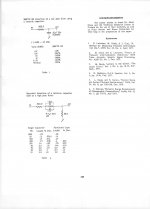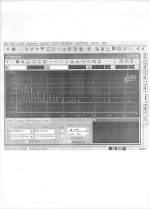It's quite mesmerising 🙂 I Am Sitting in a Room - Wikipedia
This is pretty much what T said
"Lucier was originally inspired to create I am sitting in a room after a colleague mentioned attending a lecture at MIT in which Amar Bose described how he tested characteristics of the loudspeakers he was developing by feeding back audio into them that they had produced in the first place and then was picked up via microphones."
This is pretty much what T said
"Lucier was originally inspired to create I am sitting in a room after a colleague mentioned attending a lecture at MIT in which Amar Bose described how he tested characteristics of the loudspeakers he was developing by feeding back audio into them that they had produced in the first place and then was picked up via microphones."
Not at all the same, as I see the things. Room adds resonances and reverberations.Try this. Record the same person from 3 inches and 6 feet than listen to them, theres a lot more to the difference than the room.
Distances in open field (apart proximity effect of a cardioid mic) affect response curves (plus fletcher & Munson effect in our brain due to changes of levels). Distances in a room affect the relative level of the reverberations.
>20 years ago, I had done a special box with a 'distance' button for dubbing to mimic outside recording of human voices. Several recordings at different distances of the same comedian ->frequency analyser->Analog filters. Worked pretty well. My 'two mikes+delay' tip for room distances too.
Last edited:
Just read the RN speaker test. I guess hes never recorded a voice before. Take it from some one whos tried to match hundreds of actors voices to there production dialogue, recording ADR. The mic, its angle, position, pattern, distance, and the room all sound different. Even the persons mood can change the sound.
Not really. As before, mic, angle, positon, etc all make a difference. Mic a few inches from what? ( you move a close mic on an acoustic guitar an inch closer to the f-hole youll get more low end). Most instruments produce different sounds in different directions so to hear them realisticly you and your mic need to be a few feet away, do you listen to a violin 3 inches away from it? Try this. Record the same person from 3 inches and 6 feet than listen to them, theres a lot more to the difference than the room.
Yes this is exactly right.
I'm not sure if RNM has recorded anything before it's worth writing home about.
BTW: it's good to see that RNM finally can have a closer look at the sin bin from the inside.
.
BTW: it's good to see that RNM finally can have a closer look at the sin bin from the inside.
Forum CIA ?
I'm not sure, the sub would do the heavy lifting. Besides, do you really want the full SPL of a drum kit in your living room? Bob excepted (again) of course 🙂Whatever we could try, no way, even with a sub, such a little enclosure can mimic the real energy of a drum kit, moving enough air.
Last edited:
Why not? 😀
Was eyeballing those 21” OB drivers that John Busch had in the swap meet (gone now) I’ll bet those
could get pretty close to a live kick!
Was eyeballing those 21” OB drivers that John Busch had in the swap meet (gone now) I’ll bet those
could get pretty close to a live kick!
Last edited:
That's one way of avoiding your critics, still, hands up who hasn't been there.
I've somehow dodged it, but not on my merit in a few cases where I got too nasty for my own good, that's for sure.
The landscape on this thread will surely look a little different.
WRT mic'ing and reproducing, I don't see that working unless the idea is to get one's most pleasing sound convolved with the response of the microphone itself.
Tom Danley did talk about doing voice intelligibility after multiple generations of playback and recording (near field, IIRC with a calibrated mic). Believe (and reserving every right to be utterly wrong about this) it was a performance criteria for his speaker designs.
Well folks, there it is: A real Vendetta for sale for more than 3 times the original price, and probably still worth it. That is an example of a successful combination of the 3 ingredients that I just spoke about that makes it 'legendary' rather than just OK. I haven't made a new Vendetta for more than 25 years, more like 30. Think about it! Of course, the Marantz 9 and 10 are in the same league. Try to buy one of those sometime as well. I am glad that I have known the designers of those audio components, and they are just as 'crazy' (in a good way) as me in their dedication to an ideal design. Of course, when they first come out, they probably lose money for the company, but then their intrinsic quality is appreciated over the decades.
Cyril Bateman demonstrated that there is a high correlation between dielectric absorption (and voltage across the caps) and harmonic distorsion.
For exemple, he found the ceramic COG caps are among the best for low harmonic distortion. Samuel Groner confirmed how good and reliable they are :
https://www.diyaudio.com/forums/equ...omatic-distortion-analyzer-9.html#post4549551.
It seems that since Cyril's articles, COG caps are use more often used.
I tried to ask something about DA some day ago but without any reply, maybe the crowd is tired of the subject, but what I still wonder is if the DA is non-linear with respect to the applied signal voltage, what I was wondering is if the DA gets more non-linear when closing to zero volt, do you Forr or anyone else have an opinion on this?
DA is almost entirely a LINEAR distortion, rather than a NON-LINEAR distortion as measured by harmonic or IM analysis. That is why it takes unusual test procedures to measure it adequately. A single sine wave will not do it. It usually takes an unsymmetrical pulse like waveform to bring it out and compare different caps to what you measure with a 'reference' cap like a Teflon or polystyrene cap. By the way, for most practical purposes either can be used for a 'reference' cap.
Richard Marsh first showed this back in the late 70's. Walt Jung and I, (and even Scott Wurcer) used a different test procedure, but we got measurable results in the mid-80's.
Walt, Richard, and I have never looked at a typical audio cap the same way again. It is just too obvious with a useful test set-up, to go back to Mylar or other even less performing caps, after comparing the results.
Non-linearity is a separate measurement, and can be awful with most ceramics,(especially higher value), and Tantalum caps. Less so with aluminum electrolytics, but the DA of aluminum electrolytics is very high, and therefore we tend to eliminate them and use servos instead for coupling between stages.
Richard Marsh first showed this back in the late 70's. Walt Jung and I, (and even Scott Wurcer) used a different test procedure, but we got measurable results in the mid-80's.
Walt, Richard, and I have never looked at a typical audio cap the same way again. It is just too obvious with a useful test set-up, to go back to Mylar or other even less performing caps, after comparing the results.
Non-linearity is a separate measurement, and can be awful with most ceramics,(especially higher value), and Tantalum caps. Less so with aluminum electrolytics, but the DA of aluminum electrolytics is very high, and therefore we tend to eliminate them and use servos instead for coupling between stages.
Attachments
Last edited:
Thanks a lot JC, I appreciate your reply!
What yo described is as far as I have come to understand the DA issue, I was just thinking there's some non-linear phenomenon going on when a signal approaches 0 voltage level, perhaps not necessary a DA related one then, but I was still thinking and wondering whether there's still some kind of non-linear anomaly going on which increases with decreased signal level.
Looking at the first attachment, one could conclude that is certainly not the case for ceramics whose IMD in opposite does instead increase with increased signal level which perhaps not surprising due to the Piezo effect, also very dependent on what type of ceramic dielectrics are used.
The Tantalum appears to also increase in IMD with increased signal level (second column pair), if that is the trend for other dielectric materials as well, then could one interpolate from that, the IMD could also be decreased by choosing a capacitor with as high breakdown voltage as possible for a given signal level.
What yo described is as far as I have come to understand the DA issue, I was just thinking there's some non-linear phenomenon going on when a signal approaches 0 voltage level, perhaps not necessary a DA related one then, but I was still thinking and wondering whether there's still some kind of non-linear anomaly going on which increases with decreased signal level.
Looking at the first attachment, one could conclude that is certainly not the case for ceramics whose IMD in opposite does instead increase with increased signal level which perhaps not surprising due to the Piezo effect, also very dependent on what type of ceramic dielectrics are used.
The Tantalum appears to also increase in IMD with increased signal level (second column pair), if that is the trend for other dielectric materials as well, then could one interpolate from that, the IMD could also be decreased by choosing a capacitor with as high breakdown voltage as possible for a given signal level.
DA is almost entirely a LINEAR distortion.
Almost any filter introduces a “linear distortion” (a typical example is the input low pass filter used to kill the RFI). What makes the DA “linear distortion” special?
I tried to ask something about DA some day ago but without any reply, maybe the crowd is tired of the subject, but what I still wonder is if the DA is non-linear with respect to the applied signal voltage, what I was wondering is if the DA gets more non-linear when closing to zero volt, do you Forr or anyone else have an opinion on this?
The only model of DA that I've seen has a (the) capacitor in parallel with a bunch of series'd very big R's and very big C's. This would be linear, but is just a model. ("Camelot!" "Camelot!" King: "It's just a model".) How could it be measured independently from the capacitor's other non-linearities?
LUV love the Alvin Lucier "I am Sitting in a Room".
All good fortune,
Chris
DA is almost entirely a LINEAR distortion, rather than a NON-LINEAR distortion as measured by harmonic or IM analysis. That is why it takes unusual test procedures to measure it adequately. A single sine wave will not do it. It usually takes an unsymmetrical pulse like waveform to bring it out and compare different caps to what you measure with a 'reference' cap like a Teflon or polystyrene cap. By the way, for most practical purposes either can be used for a 'reference' cap.
Richard Marsh first showed this back in the late 70's. Walt Jung and I, (and even Scott Wurcer) used a different test procedure, but we got measurable results in the mid-80's.
Walt, Richard, and I have never looked at a typical audio cap the same way again. It is just too obvious with a useful test set-up, to go back to Mylar or other even less performing caps, after comparing the results.
Non-linearity is a separate measurement, and can be awful with most ceramics,(especially higher value), and Tantalum caps. Less so with aluminum electrolytics, but the DA of aluminum electrolytics is very high, and therefore we tend to eliminate them and use servos instead for coupling between stages.
This seems to reflect CB and DS assertion that the AC voltage across the capacitor has to be minimized to get lowest distortion. In some of the tests in that paper, the cap AC voltage is very high. Self talks about <50mV AC across the cap at LF (so 10~20 Hz) for lowest distortion. you can get a hint of this by feeding a square wave into the test network. At LF, if the cap is not big enough, you get a significant slope on the tops and bottoms while at HF you get peaking.
These aspects have to be separated from DF in order to make a sensible assessment.
Ultima Thule seems to be asking if the DA effects in capacitors decrease monotonically with signal level. Because we were raised on linear and monotonic functions, we default to that mindset. It's usually perfectly fine. Well educated people whose opinions you respect will tell you that there's nothing to see here.
But. If you look at iron-cored inductors, a somewhat related device which is better studied (for their larger flaws), you find all kinds of non-monotonic behavior at small signal levels. Reaching down into the mucky depths of chemistry where lurk complications to idealized models, models bend some.
Call me a nutter, but when someone proclaims a linear monotonic model, with no size limitations, I run fast.
Always the best fortune,
Chris
But. If you look at iron-cored inductors, a somewhat related device which is better studied (for their larger flaws), you find all kinds of non-monotonic behavior at small signal levels. Reaching down into the mucky depths of chemistry where lurk complications to idealized models, models bend some.
Call me a nutter, but when someone proclaims a linear monotonic model, with no size limitations, I run fast.
Always the best fortune,
Chris
Jakob, It might be closer than you think; some modern recordings are really blowing my mind and dsp on playback fills in the gaps.....I think soon they will be encoding dsp in production to be decoded in playback then custom fit to your room in a Dirac like process. Think about the possibilities with that!
<snip>
I'd not dispute the merit or possibilities of modern processing capabilities, but wanted to point to the differences from an objective/physical angle.
If we can't reproduce the original soundfields, we have to rely either on the limitations or the capabilities of our sensory system (including the brain).
Limitations in the case if the resolution of our sense is not able to detect the differences/defections of the lossy version, or the capabilities of our brain to manufacture a convincing internal representation based on the clues given by the lossy reproduction.
Last edited:
Something like this ?The landscape on this thread will surely look a little different.
Attachments
Interesting analysis on the ESS9038 dac...
SMSL M500 Teardown & ESS ES9038Pro DAC Thermal Analysis | Audio Science Review (ASR) Forum
SMSL M500 Teardown & ESS ES9038Pro DAC Thermal Analysis | Audio Science Review (ASR) Forum
- Status
- Not open for further replies.
- Home
- Member Areas
- The Lounge
- John Curl's Blowtorch preamplifier part III


